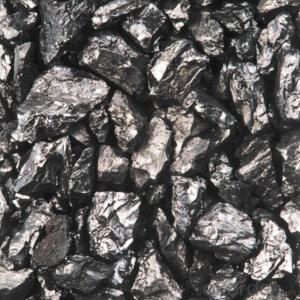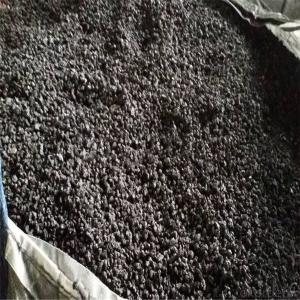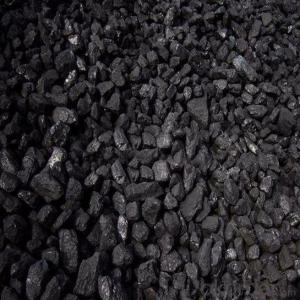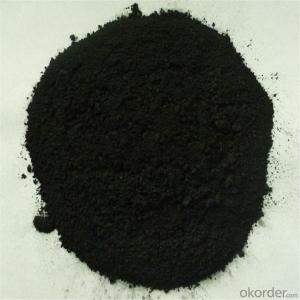Recarburizer FC > 95 High Carbon Low Sulphur For Metals Casting
- Loading Port:
- Dalian
- Payment Terms:
- TT OR LC
- Min Order Qty:
- 10 m.t
- Supply Capability:
- 500000 m.t/month
OKorder Service Pledge
OKorder Financial Service
You Might Also Like
Specifications of Recarburizer:
Carbon Additive
F.C>90% ASH<8.5% S<0.4%
F.C>92% ASH<7% S<0.4%
F.C>93% ASH<6% S<0.4%
F.C>95% ASH<4% S<0.3%
Carbon Additive Data Sheet:
Specifications (%): | ||||||
Grade | F.C | Ash | V.M | Moisture | S | Size |
CR-95 | ≥95 | <4 | <1 | <1 | <0.3 | 0-30mm |
CR-94 | ≥94 | <4 | <1 | <1 | <0.3 | |
CR-93 | ≥93 | <6 | <1 | <1 | <0.4 | |
CR-92 | ≥92 | <7 | <1 | <1 | <0.4 | |
CR-91 | ≥91 | <8 | <1 | <1 | <0.4 | |
CR-90 | ≥90 | <8.5 | <1.5 | <2 | <0.4 | |
Used as additive in steel making process. It made from well-selected anthracite which is low in content of ash, sulphur, phosphorus, high heat productivity, high chemically activation.
Mainly industry property of it is: instead of traditional pertroleum coal of Carbon Additives, reduce the cost of steelmaking.
- Q:What is the atomic weight of carbon?
- The atomic weight of carbon is approximately 12 atomic mass units.
- Q:Intend to go to the barbecue and 35 friends over the weekend, but because it is new, so I don't know how to put the carbon burning, found some web sites are also a few pens, see me confused......Hope which experienced friend to help enlighten me, the best to the specific point, thank you ah!
- A few days ago I just go to the barbecue, barbecue in the general store to buy carbon (long, with a hole in the middle of smokeless carbon) is not easy, but is cheaper, you can buy some flammable carbon on the Internet, and then get a little pure alcohol ignition when the flammable carbon below, ordinary carbon. Add a little alcohol, a little on the. It takes about 20 minutes to barbecue! Wish you have a good time.
- Q:How is carbon used in the manufacturing of electronics?
- The manufacturing of electronics relies on carbon in various ways. One of its primary uses is in the production of carbon nanotubes, which are essential in electronics. These nanotubes possess exceptional electrical conductivity and mechanical strength, making them ideal for various electronic devices. For example, they can be utilized to create high-performance transistors that are crucial components in computer chips. Furthermore, carbon is utilized in the manufacturing of batteries for electronic devices. Graphite, a carbon-based material, is commonly used as the anode material in lithium-ion batteries. This is due to its efficient storage and release of lithium ions, enabling the rechargeable nature of these batteries. Moreover, carbon is employed in the production of conductive coatings and inks used in printed circuit boards (PCBs). Carbon-based materials, such as carbon black or carbon nanotubes, are added to enhance the electrical conductivity of these coatings and inks. Consequently, the flow of electrical signals throughout the circuitry of electronic devices is ensured. In conclusion, carbon plays a crucial role in the manufacturing of electronics. It is utilized in the production of carbon nanotubes for high-performance transistors, serves as anode material in lithium-ion batteries, and enhances the electrical conductivity of conductive coatings and inks for printed circuit boards. These applications emphasize the versatility and significance of carbon in the electronics industry.
- Q:Appearance, hardness, electrical conductivity, use of carbon 60
- C60 does not normally conduct electricity because C60 is so large that it can put other atoms into it and affect its physical properties, so it cannot be electrically conductiveUsed to strengthen metalImprove the metal material strength by alloying, plastic deformation and heat treatment, one of the ways to strengthen the interaction through geometry, such as coke carbon dispersed in the metal, carbon and metal exchange position in the crystal lattice, can cause plastic deformation of metal, carbon and metal carbide particles that can make the metal enhanced. In the enhancement of metal materials, the effect of C60 ratio of carbon in coke is better, this is because the C60 is higher than the smaller particles, active carbon, particle size of C60 with metal carbide dispersion effect is 0.7nm, and the particle size of carbon and metal carbide dispersion effect the body is 2 m ~ 5 m, has a larger difference in enhancing the role of the metal.Used as a new catalystIn C60, the electronic structure of chemists began to explore the possibility of.C60 catalyst for C60 with olefin, with transition metal (such as platinum and nickel metal) to form a series of complexes. For example C60 and platinum, osmium can be combined into {[(C2H5) 3P]2Pt}C60 and C60OsO4 (four butylpyridine) and other coordination compounds and they are likely to become the efficient catalyst.Japanese researchers Toyohashi University of science and technology of the synthesis of highly catalytic activity of palladium Pt synthesis researchers and C60 compound C60Pd6. China Wuhan University (PPh3) 2C60 (PPh3 three, triphenylphosphine) for hydrosilylation reaction with high catalytic activity.
- Q:What should we do to reduce carbon emissions in our lives?
- Reducing the burning of fossil fuels is important, reducing the emission of motor vehicles, reducing private cars, reducing thermal power, and burning carbon emissions from coal-fired power plants
- Q:What are the impacts of carbon emissions on the stability of river ecosystems?
- The stability of river ecosystems is significantly affected by carbon emissions, which have various consequences. One of the main outcomes of carbon emissions is the rise in greenhouse gases in the atmosphere, resulting in global warming. This increase in temperature directly and indirectly impacts river ecosystems. To begin with, higher temperatures can modify the physical characteristics of rivers and impact the availability of oxygen in the water. Warmer water holds less dissolved oxygen, which can be harmful to aquatic organisms like fish and invertebrates that depend on oxygen for survival. The decrease in oxygen levels can lead to a decrease in biodiversity and even cause fish to die. Furthermore, climate change caused by carbon emissions can disrupt the natural hydrological cycle. Changes in precipitation patterns can lead to droughts or floods, causing fluctuations in river flow. These alterations can affect the reproductive and migration patterns of many aquatic species, disturbing their life cycles and reducing their populations. Additionally, modified river flows can also affect the stability of riverbank and riparian habitats, resulting in erosion and habitat loss. Moreover, increased carbon emissions contribute to ocean acidification. When water absorbs carbon dioxide, it forms carbonic acid, which lowers the pH of the water. Acidic waters can have harmful effects on aquatic life, including shellfish, corals, and other organisms that calcify. River ecosystems are interconnected with coastal and marine ecosystems, so the consequences of ocean acidification can indirectly impact river ecosystems through the food chain. Furthermore, carbon emissions contribute to the deposition of air pollutants, such as nitrogen and sulfur compounds, onto land and water bodies. These pollutants can be carried by rainfall into rivers, leading to increased nutrient levels and eutrophication. Excessive nutrients can cause harmful algal blooms, deplete oxygen levels, and create dead zones, further disturbing the balance of river ecosystems. In conclusion, the stability of river ecosystems is profoundly impacted by carbon emissions. Rising temperatures, altered hydrological cycles, ocean acidification, and increased nutrient levels all contribute to the degradation of these ecosystems. It is essential to reduce carbon emissions and adopt sustainable practices to mitigate these impacts and preserve the health and stability of river ecosystems.
- Q:How does deforestation contribute to carbon dioxide levels in the atmosphere?
- Deforestation contributes to carbon dioxide levels in the atmosphere primarily through the release of stored carbon in trees and vegetation. When forests are cut down or burned, the carbon stored in their biomass is released as carbon dioxide, a greenhouse gas. Additionally, trees play a crucial role in absorbing carbon dioxide during photosynthesis, so their removal reduces the capacity to remove this greenhouse gas from the atmosphere. Therefore, deforestation not only releases carbon dioxide but also diminishes the natural carbon sinks, leading to an overall increase in carbon dioxide levels in the atmosphere.
- Q:How does carbon impact the availability of clean transportation?
- Carbon emissions from burning fossil fuels contribute to climate change, which affects the availability of clean transportation. Increased levels of carbon dioxide in the atmosphere trap heat, leading to rising global temperatures and extreme weather events. This, in turn, impacts the infrastructure necessary for clean transportation, such as roads, bridges, and railways. Additionally, carbon-intensive transportation systems, like gasoline-powered vehicles, contribute to air pollution, which further hinders the development and adoption of cleaner transportation alternatives like electric vehicles.
- Q:How does carbon dioxide contribute to ocean acidification?
- Ocean acidification is caused by the presence of carbon dioxide, which forms carbonic acid when it dissolves in seawater. This reaction results in an increase in hydrogen ions and a decrease in pH, making the water more acidic. Human activities, especially the burning of fossil fuels, are leading to a rise in carbon dioxide emissions. As a result, more carbon dioxide is being absorbed by the oceans, disrupting the natural balance between atmospheric and oceanic carbon dioxide levels. This excess absorption leads to an accumulation of carbon dioxide in the seawater. The increased acidity of the seawater poses a significant threat to marine life. Many organisms, such as corals, shellfish, and certain types of plankton, rely on calcium carbonate to construct their shells or skeletons. However, in more acidic water, the availability of carbonate ions, necessary for calcium carbonate formation, decreases. Consequently, these organisms struggle to build and maintain their protective structures, rendering them more susceptible to predation and other dangers. Ocean acidification also has adverse effects on the growth, development, and behavior of numerous other marine species. For example, it can disrupt fish reproductive cycles and alter the behavior of certain species, making them more vulnerable to predators or adversely affecting their ability to locate food or mates. Moreover, ocean acidification can trigger a chain reaction that impacts entire marine ecosystems. The interconnectedness of species in complex food webs means that any disturbance to one species can have far-reaching consequences for others. If the population of a particular fish species declines due to acidification, it can have a ripple effect on the entire food chain, influencing the abundance and distribution of other species. In conclusion, the process of ocean acidification occurs as carbon dioxide dissolves in seawater and forms carbonic acid, resulting in an increase in hydrogen ions and a decrease in pH. This process has detrimental effects on marine organisms, particularly those reliant on calcium carbonate for their shells or skeletons. It also disrupts the growth, development, and behavior of various marine species and can have cascading impacts on entire ecosystems.
- Q:Often see the so-called 30T, 46T, 60T carbon fiber, 60T carbon fiber, equivalent to T hundreds of carbon fibers, is T800, or T1000? I'm not very good at parameter conversion. Is there a parameter list? How do I correspond to the T300T700T800 performance parameter table?
- Three, T300, T700, T800, T1000 intensity were 3530MPa, 4900MPa, 5880MPa, 6370MPa;The intensities of M46 and M60 were 4020MPa and 3820MPa respectively.
1. Manufacturer Overview |
|
|---|---|
| Location | |
| Year Established | |
| Annual Output Value | |
| Main Markets | |
| Company Certifications | |
2. Manufacturer Certificates |
|
|---|---|
| a) Certification Name | |
| Range | |
| Reference | |
| Validity Period | |
3. Manufacturer Capability |
|
|---|---|
| a)Trade Capacity | |
| Nearest Port | |
| Export Percentage | |
| No.of Employees in Trade Department | |
| Language Spoken: | |
| b)Factory Information | |
| Factory Size: | |
| No. of Production Lines | |
| Contract Manufacturing | |
| Product Price Range | |
Send your message to us
Recarburizer FC > 95 High Carbon Low Sulphur For Metals Casting
- Loading Port:
- Dalian
- Payment Terms:
- TT OR LC
- Min Order Qty:
- 10 m.t
- Supply Capability:
- 500000 m.t/month
OKorder Service Pledge
OKorder Financial Service
Similar products
New products
Hot products
Related keywords






























